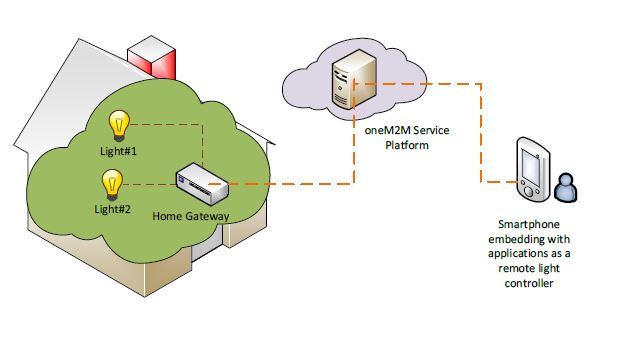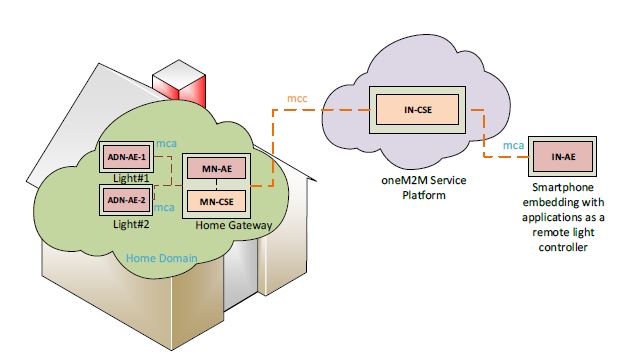Light control: Difference between revisions
No edit summary |
No edit summary |
||
| (12 intermediate revisions by the same user not shown) | |||
| Line 3: | Line 3: | ||
</div> | </div> | ||
----- | ----- | ||
__TOC__ | |||
== Use case description == | |||
The described use case enables the remote control of lights via a smartphone which embeds an application that gains access to a oneM2M service platform. | The described use case enables the remote control of lights via a smartphone which embeds an application that gains access to a oneM2M service platform. | ||
The main components are introduced as follows: | The main components are introduced as follows: | ||
| Line 8: | Line 11: | ||
[[File:lamp_diagram1.jpg]] | [[File:lamp_diagram1.jpg]] | ||
<ol> | <ol> | ||
<li>Light lamps shown in the current use case are deployed at a house and attached to a home gateway. The light lamps are able to interact with a oneM2M platform through a wireless access interface. | <li>Light lamps shown in the current use case are deployed at a house and attached to a home gateway. The light lamps are able to interact with a oneM2M platform through a wireless access interface. | ||
</li> | </li> | ||
<li>The home gateway is configured to be able to search and connect light lamps into itself and to communicate with a oneM2M service platform in terms of exchanging and storing light lamps states between the light lamps and the oneM2M service platform. | <li>The home gateway is configured to be able to search and connect light lamps into itself and to communicate with a oneM2M service platform in terms of exchanging and storing light lamps states between the light lamps and the oneM2M service platform. | ||
| Line 16: | Line 19: | ||
<li>The smartphone application is embedded into a smartphone and acts as a remote light controller with capabilities as the follows: | <li>The smartphone application is embedded into a smartphone and acts as a remote light controller with capabilities as the follows: | ||
</li> | </li> | ||
<ul> | <ul> | ||
<li>Discovery of light lamps deployed into the home gateway. </li> | <li>Discovery of light lamps deployed into the home gateway. </li> | ||
| Line 23: | Line 24: | ||
<li>Retrieval of light states. </li> | <li>Retrieval of light states. </li> | ||
</ul> | </ul> | ||
== Architecture == | |||
This clause describes the architecture of the implemented use case with components represented by the oneM2M entity roles. For instance, a physical device can be modelled as an ADN-AE and the oneM2M service system can be modelled as an IN-CSE, etc. | |||
The remote lights control use case shown in figure 5.1 can be mapped into the oneM2M functional architecture depicted in figure 6.1. | |||
[[File:lamp_diagram2.jpg]] | [[File:lamp_diagram2.jpg]] | ||
< | In oneM2M functional architecture two entity roles are defined, one is AE and the other is CSE. Application dedicated devices e.g. light lamps are usually acted as an ADN-AE. Smartphone applications that are embedded into smartphone devices and able to communicate directly with oneM2M service platform can also be acted as an ADN-AE. oneM2M service system is acted as an IN-CSE and the home gateway plays a role of MN-CSE. | ||
== | Two reference points, mca and mcc which are defined in the oneM2M functional architecture are used between AE and CSE and between two CSEs in the current use case, respectively. As figure 6.1 shows, the reference point used between any light application (ADN-AE-1 or ADN-AE-2) and home gateway MN-CSE is mca while that of between home gateway and oneM2M service platform is mcc. | ||
In summary, applications used in the current use case are classified as follows: | |||
<ol> | |||
<li>ADN-AE1: an application embedded in the light lamp Light#1 with capabilities to control light lamp Light#1 and interact with the home gateway MN-CSE through mca reference point;</li> | |||
<li>ADN-AE2: an application embedded in the light lamp Light#2 with capabilities to control light lamp Light#2 and interact with the home gateway MN-CSE through mca reference point; | |||
</li> | |||
<li>IN-AE: a smartphone application embedded in the smartphone device with capabilities to interact directly with the oneM2M service platform IN-CSE through mcc reference point and thereby remotely control light lamps Light#1 and Light#2; | |||
</li> | |||
<li>MN-AE: a gateway application embedded into the home gateway MN-CSE and interact with MN-CSE through mca reference point. | |||
</li> | |||
== Procedure == | |||
<ol> | |||
<li><B>Registration:</B> The current procedure contains light lamps registration, gateway application registration, and accessControlPolicy resource creation for a selective access to data storage resources.</li> | |||
<li><B>Initial resource creation:</B> The current procedure contains group resources creation, container resources creation with specific access control policies, content instance resources creation with initial light states, subscription resources creation for notifications. | |||
</li> | |||
<li><B>Discovery of container resource:</B> all containers with a specific filter criteria can be discovered by the gateway application and provided as members of group resources. | |||
</li> | |||
<li><B>Discovery and retrieval lights states:</B> all containers with a specific filter criteria could be discovered and retrieved using resource identities through a smartphone application which gains access to oneM2M service platform and content information could also be retrieved. | |||
</li><B>Single light switch on/off:</B> Any light that is discovered by and connected to the smartphone application is able to be switched on and off via a smartphone application. | |||
<li> | |||
</li> | |||
<li><B>Multiple lights switch on/off:</B> More than one lights that are discovered by and connected to the smartphone application are able to be switched on and off together via a smartphone application. | |||
</li> | |||
== Implementations == | |||
TBD | |||
Latest revision as of 10:05, 14 October 2016
Use case description
The described use case enables the remote control of lights via a smartphone which embeds an application that gains access to a oneM2M service platform. The main components are introduced as follows:
- Light lamps shown in the current use case are deployed at a house and attached to a home gateway. The light lamps are able to interact with a oneM2M platform through a wireless access interface.
- The home gateway is configured to be able to search and connect light lamps into itself and to communicate with a oneM2M service platform in terms of exchanging and storing light lamps states between the light lamps and the oneM2M service platform.
- oneM2M service platform provides vertical application services targeted at different field domains, for instance, home, vehicle, and industry. The oneM2M service platform supports a group of common service functionalities such as registration, discovery, data management, group management, subscription/notification etc.
- The smartphone application is embedded into a smartphone and acts as a remote light controller with capabilities as the follows:
- Discovery of light lamps deployed into the home gateway.
- Sending commands to change light states i.e. ON and OFF.
- Retrieval of light states.
- ADN-AE1: an application embedded in the light lamp Light#1 with capabilities to control light lamp Light#1 and interact with the home gateway MN-CSE through mca reference point;
- ADN-AE2: an application embedded in the light lamp Light#2 with capabilities to control light lamp Light#2 and interact with the home gateway MN-CSE through mca reference point;
- IN-AE: a smartphone application embedded in the smartphone device with capabilities to interact directly with the oneM2M service platform IN-CSE through mcc reference point and thereby remotely control light lamps Light#1 and Light#2;
- MN-AE: a gateway application embedded into the home gateway MN-CSE and interact with MN-CSE through mca reference point.
- Registration: The current procedure contains light lamps registration, gateway application registration, and accessControlPolicy resource creation for a selective access to data storage resources.
- Initial resource creation: The current procedure contains group resources creation, container resources creation with specific access control policies, content instance resources creation with initial light states, subscription resources creation for notifications.
- Discovery of container resource: all containers with a specific filter criteria can be discovered by the gateway application and provided as members of group resources.
- Discovery and retrieval lights states: all containers with a specific filter criteria could be discovered and retrieved using resource identities through a smartphone application which gains access to oneM2M service platform and content information could also be retrieved. Single light switch on/off: Any light that is discovered by and connected to the smartphone application is able to be switched on and off via a smartphone application.
- Multiple lights switch on/off: More than one lights that are discovered by and connected to the smartphone application are able to be switched on and off together via a smartphone application.
Architecture
This clause describes the architecture of the implemented use case with components represented by the oneM2M entity roles. For instance, a physical device can be modelled as an ADN-AE and the oneM2M service system can be modelled as an IN-CSE, etc. The remote lights control use case shown in figure 5.1 can be mapped into the oneM2M functional architecture depicted in figure 6.1.
In oneM2M functional architecture two entity roles are defined, one is AE and the other is CSE. Application dedicated devices e.g. light lamps are usually acted as an ADN-AE. Smartphone applications that are embedded into smartphone devices and able to communicate directly with oneM2M service platform can also be acted as an ADN-AE. oneM2M service system is acted as an IN-CSE and the home gateway plays a role of MN-CSE.
Two reference points, mca and mcc which are defined in the oneM2M functional architecture are used between AE and CSE and between two CSEs in the current use case, respectively. As figure 6.1 shows, the reference point used between any light application (ADN-AE-1 or ADN-AE-2) and home gateway MN-CSE is mca while that of between home gateway and oneM2M service platform is mcc.
In summary, applications used in the current use case are classified as follows:
Procedure
Implementations
TBD

